God and Guns: Why American Churchgoers Are Packing Heat
Jeff Henry (center) explains shooting technique to members of the Mountain Springs Church life safety team in Colorado, while practicing at a gun range in March 2020. Photo by Paul Glader.
COLORADO SPRINGS, Colo. — Jeff Henry wears a Glock handgun, a hunting knife and steel handcuffs on his belt as he stares warily toward a man with an AR-15 assault rifle who approaches his church.
“I want to see my son!” the man yells.
Henry watches as church member Kent Lambert, 67, draws a handgun, yells “Drop it now!” then charges the man, knocks the assault rifle out of his hands and pushes him out the door.
With that, the Mountain Springs Church life safety team has completed a live drill (using fake guns) in early March, right as COVID-19 quarantines started and well before the protests about George Floyd’s death began. The roughly 20 life safety team members at this quarterly training then gather in a circle to deconstruct Lambert’s performance.
“We could have yelled, ‘GUN! GUN! GUN! Lockdown!’ as soon as we saw the gun,” Henry says. The men talked about strategies to record the license plates of the gunman. They suggested Lambert keep his hands up in a defensive pose in case the visitor tried to punch. They discussed whether Lambert, a former Air Force officer and state legislator, could have legally shot the intruder (played by church member Bryan Sanson, 42) if the scenario were real.
“Yes! You shoot him!” says one group member. “Someone who walks into a church with an AR is probably not there for the cookies.”
Before COVID-19 quarantines and protests over racial injustices, people of faith who attend church, synagogue, mosque and other places of worship have been increasingly thinking about security measures. After 19 fatal shootings at houses of worship since 2000, more Christians across the U.S. from Texas to Maine are toting guns to church. LifeWay Research, an arm of the Southern Baptist Convention, conducted a telephone survey of 1,000 Protestant pastors in 2019 and found 45 percent said their security measures involve armed church members. In the same survey, 62 percent said they have some plan for an active shooter and 80 percent said they have a security measure in place during worship. This all makes for an odd moment in church history and brings tension with theology that emphasizes non-violence.
“We are striking a balance between the Great Commission and security,” said the Rev. Mike Sowers of First Baptist Church in Buies Creek, North Carolina. A handful of his parishioners bring pistols to church along with their Bibles. They shoot targets at gun ranges as readily as they send up supplications during prayer meetings, always on high alert for any dangerous people. And he says other churches in his area are also more active about security. “We trust God and the need to secure our building, but we want to do it in a way that doesn’t impede the mission.”
The Dec. 29, 2019 shootout at West Freeway Church of Christ in Texas was a signal moment for the growing security movement within churches. A drifter who pulled a gun during communion and shot two church members was shot dead by a deacon in a gun battle viewed widely on YouTube. The example left many gun control activists quiet. For guns rights activists, it validated the National Rifle Association view that guns deter and detain crime.
During the seven-hour training session at Mountain Springs Church in Colorado on a recent Saturday, Henry got emotional as he opened in prayer. “There’s no reason to be fearful,” he says, referring to coronavirus pandemic fears and church violence incidents. “But there’s reason to be prudent.” Henry gives an overview of purpose and tactics, and he teaches the importance of situational awareness, of “DLR — if something don’t look right, don’t ignore it. Say something.”
He then focuses on a replay and analysis of the Texas incident. “We owe it to those who lost their loved ones that day to be better sheepdogs,” he said, before queuing up a video of the shooting at West Freeway Church of Christ on a big screen so they could talk through it frame-by-frame for about an hour in the upstairs community room of his church.
“This is the bad guy right here,” Henry says, using his laser pointer.
“He looks like Darth Vader!” says one team member.
“First of all, it happened so darn fast!” Henry says, noting it was six seconds from when the drifter pulled a shotgun and shot two people before he was shot and killed.
The group points out positives of the Texas church members. Then they critique weaknesses. They point out an usher who acted too passively in the situation and was shot. They note one church member had a hard time drawing his handgun and was shot.
“He obviously lost his life because he was just too slow!” Henry says. “It’s why we train under time pressure scenarios.”
The group praises Wilson, who brought down the killer.
“This is clearly the result of a well-trained guy,” Henry says.
As the group re-watched the video several times, some wondered how the man in a wig and oversized coat got into the church in the first place. “For your safety in mind, can we see what’s under your coat?” they suggest asking him.
They also wonder why some church members strode through the aisles brandishing handguns but not using proper “muzzle control” — techniques to avoid pointing the gun barrel at other people. They laugh about one man who stuffed his handgun under his armpit while he called 911 — unsafe technique. They talk about the need for ushers and greeters to serve as spotters and yellers for attackers, creating a “huge force multiplier.”
Jeff Henry is a leader of the life safety team at the Mountain Springs Church near Colorado Springs, Colo., and is part of a growing movement of armed churchgoers aiming to defend their flock. At this training session at his church in February of 2020, Henry leads a case study of a December 2019 shooting at West Freeway Church of Christ in Texas. Photo by Paul Glader.
The Federal Bureau of Investigation recognizes the growing trend of church shooters and understands that churchgoers will be taking safety into their own hands more often. "Everyone who attends a service deserves the right to do so in peace,” said Assistant Director Kerry Sleeper of the FBI’s Office of Partner Engagement in a 2019 statement. “That’s certainly our common goal here as we move forward.”
Locked and loaded parishioners acting like John Wayne of the church pews may be a new chapter in church history. Historically, Christians have been hesitant to deploy violence for self-protection. While the Bible and church history illustrate tension around violence, armed resistance isn’t completely foreign to Christendom.
A History of Non-Violence in Christianity
In the Old Testament, Nehemiah anticipated John Webster, who said, “Old friends, like old swords, still are trusted best.” Nehemiah kept a mason’s trowel in hand as he rebuilt the walls of Jerusalem and relied on his old friend, the sword, to fend off attacks. In Nehemiah 4, when the Arabs, the Ammonites and the people of Ashdod heard about repairs to Jerusalem’s walls, “They were angry. They all plotted together to come and fight against Jerusalem and stir up trouble against it. But we prayed to our God and posted a guard day and night to meet this threat.” So Nehemiah stationed people at key points with “swords, spears and bows.” The men brandished their weapons as they rebuilt the walls, ready to strike when an armed threat arose.
Then, in the New Testament, the Gospels report Jesus himself grew angry and launched a carefully planned “temple tantrum” to rid merchants from selling goods in the temple. Scripture says Jesus turned over tables full of coins and chased away animals. John’s report even said Jesus took time to make a whip from cords.
Meanwhile, in seeming contradiction, the Gospels also quote Jesus telling people not to settle scores “eye for eye, and tooth for tooth.” Rather, Jesus said, “Do not resist an evil person. If anyone slaps you on the right cheek, turn to them the other cheek also.” Furthermore, in Romans 12:19-21, Paul urges the Romans not to take revenge but “leave room for God’s wrath, for it is written, ‘It is mine to avenge; I will repay,’ says the Lord.” Paul further complicates the godly response urging Christians to be kind to their enemies and “Do not be overcome by evil, but overcome evil with good.”
Dr. Michael Glerup is the executive director for Center for Early African Christianity at Yale University. He said the ancient Christian church allowed some space for self-defense, but the monastic tradition practiced passive resistance as an ideal. “On the frontiers, where raids were frequent,” we find several cases where “bishops requested protection from government officials,” he says.
He says monks in monasteries in Egypt rarely fought back when marauders attacked. Over time, some governments built fortified walls around monasteries and keeps (a term for towers) to protect monks inside. “Nubians fought back aggressors with well-trained archers,” he says. “They didn’t see any contradiction between the practice of Christianity and the protection of their people.”
With a devastating loss at Yarmuk in 636 to the Arab Muslims, the Byzantine (then Roman) rule faltered in the Middle East. After centuries of seesaw strength, the Byzantine eventually fell to the Ottomans in 1453. Prominent Christian sites from Constantinople to Corinth fell under Muslim control.
History also records the church erecting fortresses for protection, including some German Lutheran churches and communities in Romania that were built as fortresses. Some churches in Spain were armed during the Reconquista such as the city of Avila, which still boasts a cathedral built into one of its mighty walls, one of its towers serving as part of the city’s defenses.
Knights Templar and other military orders sprang up to protect pilgrims making their way to the Holy Land as well as to provide hospitals to people of all faiths in Jerusalem. The Knights of Malta were a military religious order, who proudly featured the Christian cross in their uniforms and served as the shock troops against Islamic Ottoman invaders until 1798, when Napoleon invaded the island of Malta and ended the Crusades.
Some Christian denominations such as Unitarians, Amish, Quakers and Mennonites are adamantly opposed to weapons and violence even in self-defense. Myles Werntz, an associate professor of Christian Ethics and Practical Theology in the Logsdon Seminary at Texas’ Hardin-Simmons University, is opposed to arming church members. In his upcoming article in the Review & Expositor academic journal, he refers to Matthew, where Christ tells his listeners not to hate enemies but to love them.
“Worship and a show of force, even in the defense of our lives, are incompatible by the lights of the New Testament,” Werntz said in a phone interview. “To combine them is to try to run behind Jesus in our reading of the Scripture.” He believes arming congregations tends to unhook the worship of God and deny the need for hospitality shown by the church. Werntz says wise planning and prudent measures may include installing security systems where people are buzzed in at the church during the week, or having greeters monitor who is coming to worship. Arming members, he thinks, goes too far.
David Flaud, 61, of rural Newburg in South Central Pennsylvania knew attendees of a West Nickel Mines School in the Old Order Amish community that was attacked in 2006 when a gunman shot 10 girls, killing five, before committing suicide. Flaud says he and other Amish believe Christians have been persecuted, even until death by burning at the stake, throughout church history. “It’s God’s plan,” he said. “We don’t understand it.”
The Gospel of John Wayne
The gospel of guns, meanwhile, is developing its own theology and lingo in American churches. Men in churches across the Midwest, the Deep South and other parts of America find purpose and meaning as part of a church security team, the way other church members are part of the choir, the church band or the interpretive dance team.
Pew Research in 2018 reported that Christian women are more religious than men. It found 72 percent of women say religion is “very important” in their lives compared to 62 percent of U.S. Christian men. It found women more often believe God exists, that the Bible is the word of God. It found women say they pray and attend church more regularly than men.
Women tend to be peacekeepers, says Dr. Deborah Strong, an ordained minister, missionary and professor. "Personally, I would find armed defense teams offensive and quite possibly dangerous," she said. "Violence just breeds more violence in the long run. It has no place in the church."
Strong spent a career in South Asia and is a pacifist, noting:
"I believe since we now live in the dispensation of grace or the age of grace, which began at Pentecost, the New Testament is our guide for daily living. Romans tells us not to repay evil for evil and not to take revenge (Romans 12:17,19). We are instructed to be imitators of Christ. He said turn the other cheek. He did so himself time and time again. He did not fight back when they crucified Him. Christ never used a weapon to defend Himself. It follows we should do likewise."
For Dr. Kathryn M. Lopez, associate professor of Old Testament at Campbell University, women are particularly attuned to threats of violence as mothers who want to protect their children. "I am not a martyr," said Lopez, an elder at a Disciples of Christ church in Dunn, North Carolina. "But guns in the worship service are not the answer."
While Tasers may be a better alternative, she said, the key issue is the idea of the moral injury, where people who carry sidearms to church must possess the expectation that they will not only shoot someone but can sustain a personal injury of the psyche by hurting someone. "A person can do damage to himself or herself by shooting another human being in the name of Jesus," she said.
Like Werntz and others, Lopez suggested churches use greeters stationed at every exit to be vigilant but practice the act of Jesus in the Garden of Gethsemane. When Roman soldiers arrived to arrest Jesus, Peter used his sword. "Jesus said to put away the sword," Lopez said.
Meanwhile, the church security movement has pioneered its own terminology, with men saying they are “responding to a call.” They are part of a “team.” They are called to be “protectors” of their friends and family. They call themselves “gatekeepers” or “watchmen” or “sheepdogs.”
Military, special forces and government intelligence specialists serve in the life safety teams of some churches in the United States. Some members of a church security team in Colorado Springs, Colo., practice their shooting speed and accuracy using a laser beam simulator in a friend’s basement. Photo by Paul Glader.
Religion Unplugged reporters spoke with more than two dozen church security team members in Colorado, South Dakota, Nebraska and other states, most of them men and many of them special operations soldiers, retired military officers and avid hunters. The men say they see protection of fellow churchgoers as part of their personal ministry. They enjoy the camaraderie of training with each other, discussing all aspects of security tactics and being on the alert at strategic vantage points during a church service.
They say a lot of American church men don’t want to be ushers, coffee servers and greeters. “They are not face time people. They are not gregarious people, but they still want to serve. They know they can step in if there is a situation. They will go toward a threat,” said one church security movement leader, who wanted to remain anonymous.
In Colorado Springs, security teams at several churches communicate over messaging apps to share best practices, help identify weaknesses and conduct joint training seminars. They say they are on call if another church needs help. They share gun ranges. Some have convinced their pastors to allow for special response gear such as assault rifles and body armor in case a heavier assault or coordinated attack happens. Some say they are practicing just as regularly during the pandemic and have run undercover security operations during racial injustice protests in recent days.
“The church security movement says you come into our house of worship aiming to do harm, you will leave in a pine box,” said the leader of one church security team, a former special forces soldier. “I would be surprised if any church in North America doesn’t have armed security.”
Out on the great plains of rural western South Dakota, church security has a different feel, as cattle ranchers increasingly bring their guns into small, one-room churches rather than leaving firearms in their pickup trucks or at home. “Almost every church out here has a number of armed parishioners who have taken some training and sit in specific places for security,” says Travis Mickelson, a rancher who attends Prairie Home Church, near Mud Butte, in rural western South Dakota. He describes them as “human guardian dogs.”
He said that when he was growing up in the 1990s in that region, the church-going ranchers likely didn’t take guns to church. Mickelson said even though most people know each other at churches in rural South Dakota’s Meade County, recent news of shootings at churches “awakens the caution level.” And he said the Keystone oil pipeline running through the region brings some strangers to the area. Mickelson said most people in rural South Dakota carry concealed firearms part of the time and know how to use them for hunting and pest control on the ranch.
He understands some people might not understand the motivation for Christians to be trigger happy and paranoid. “Forgive me, but I’m a shepherd [who owns and takes care of sheep by the hundreds] and I have guardian dogs,” he says. “The comparison is real and striking,” he said, noting that predators who hate religion and prey on religious people is real according to world and national news.
Religion Unplugged traveled to Colorado Springs, Colo., in March to meet Carl Chinn, a leader of the life safety movement within American churches. They also attended and reported on a life safety team training of Mountain Springs Church in Colorado. This mini-documentary seeks to understand and explain the reason many American churchgoers are gravitating to the concept of trained teams using firearms as a safeguard in houses of worship.
A Growing Movement
Church security has also become a cottage industry of sorts. Dozens of small firms nationwide have opened small security service, training organizations and consulting practices. Two large associations include the Faith Based Security Network (FBSN) based in Colorado Springs, and another is the National Organization of Church Safety and Security Management (NOCSSM), which is the oldest and biggest.
NOCSSM is a nonprofit based in Aubrey, Texas, which has many member churches across the United States who pay $120 per year. Its educational resources include security templates, training videos and a national conference. Speakers at NOCSSM’s annual conference address topics such as short-term mission trip security, security in private Christian schools and tactics in active shooter situations.
NOCSSM’s motto is “protecting God’s people” and its secondary motto is “Training the called and calling the trained.” It points to 1 Chronicles 9:21-27 as its founding scripture, a passage in which gatekeepers were identified to watch the gates of the House of the Lord, the house of the Tabernacle, “as guards.”
Founder and president Chuck Chadwick was former director of security at several mega-churches in the Dallas-Fort Worth area. His web site quotes Jesus in Luke 22:36, “Now if you have a purse, take it, and also a bag; and if you don’t have a sword, sell your cloak and buy one.”
Carl Chinn, founder and president of the Faith Based Security Network, is based in Colorado Springs, and he serves as a guru of the church security movement. His organization has more than 400 members paying a $75 annual fee, and takes its motto from Nehemiah 4:9: “We prayed to our God and posted a guard…” Scripture verses rotating on his web site also cite portions of Zechariah 9:8, “For now, I am keeping a watch;” Romans 12:9, “Abhor evil, hold fast to good;” and Corinthians 13:7: “Love always protects.”
Once a professional animal trapper and fur tradesman in Kansas, Chinn worked at Focus on the Family in the 1990s and was one of four hostages taken in 1996 by a gunman, a situation defused by hostage negotiators. That experience made him realize how “it could happen here” can change to “it happened here.”
Chinn helped develop a life safety ministry at New Life Church in Colorado in 2005 and was part of the security team who responded to a killer coming down a church hallway in 2007, who killed one person and injured four others before a woman who was part of the life safety team shot the gunman.
This latter incident served as a wake-up call, igniting a growing church safety and security movement in Colorado Springs, which is home to five military bases and more lenient gun ownership laws. A culture of hunting, outdoors and military personnel combined with many national ministries based in the area have made Colorado Springs an epicenter of the church security movement, with Texas and other places serving as additional hubs. Carl Chinn is regarded as one of the godfathers of the movement.
“I gave my life to the Lord in 1979. I no longer need to hear salvation messages. I (and many I know) am simply wired differently than many of those who sit in the pews each week,” Chinn says. “I and many I know are just more satisfied to serve in an area where we feel needed in a way that can protect my grandchildren and others.”
After the New Life Church shooting in 2007, hundreds of people from Catholic, Latter-day Saints (Mormon) and Protestant denominations came to meetings in Colorado Springs. “We decided to put together a coalition,” Chinn says, speaking in his barn that doubles as a home office, a man cave and display room for the pelts of animals he tracked and the horns of elk he hunted with his sons.
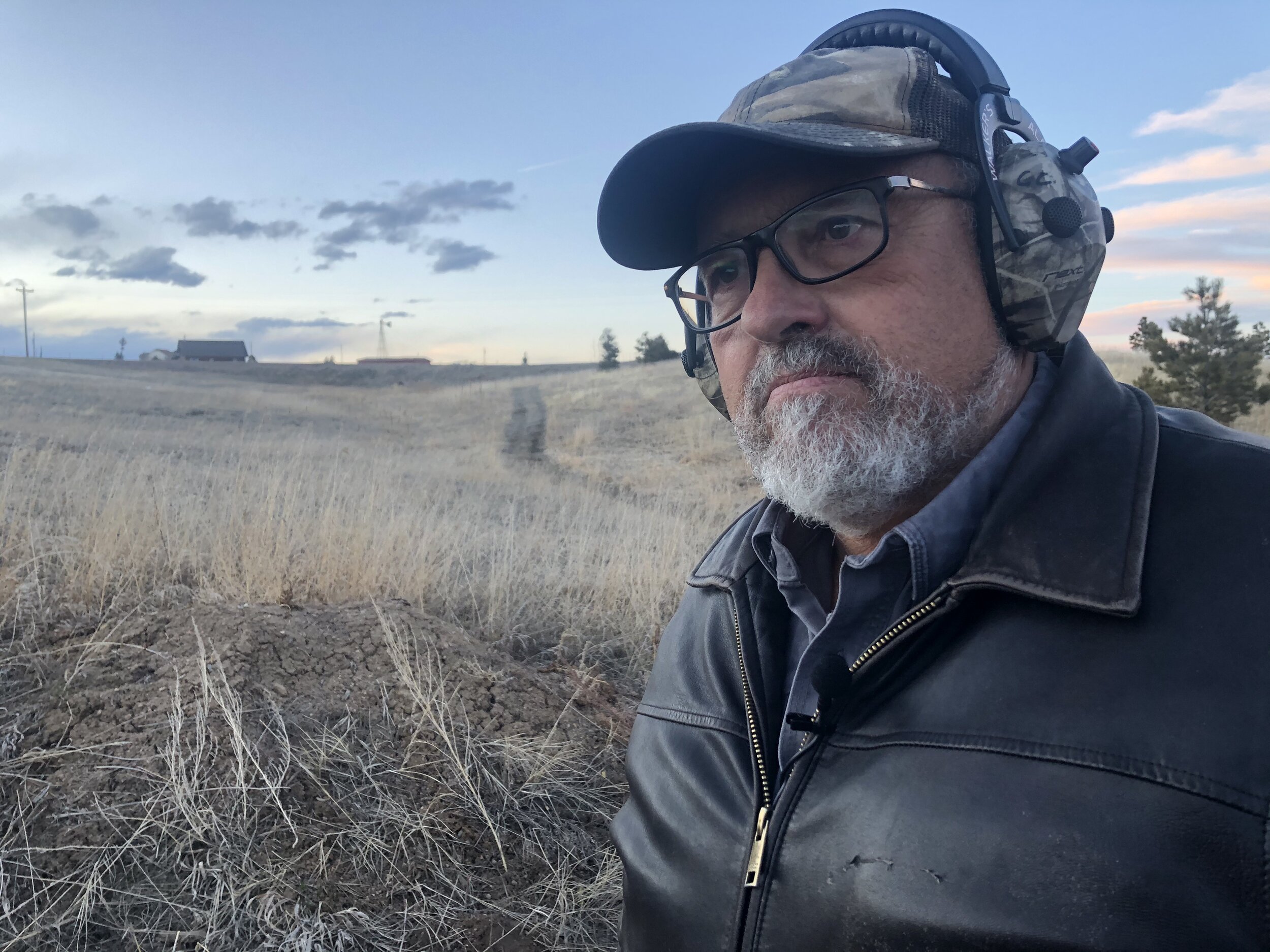
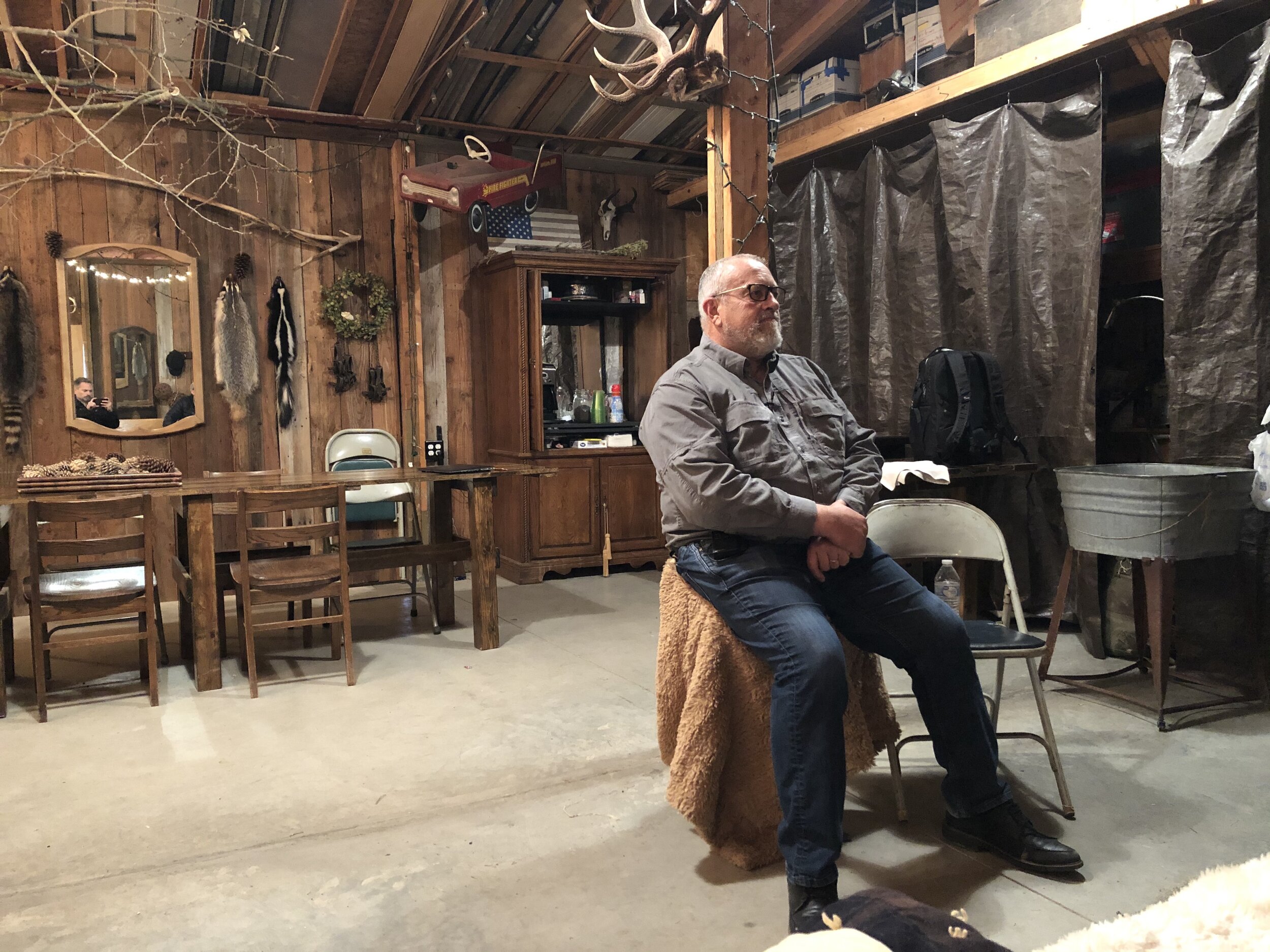

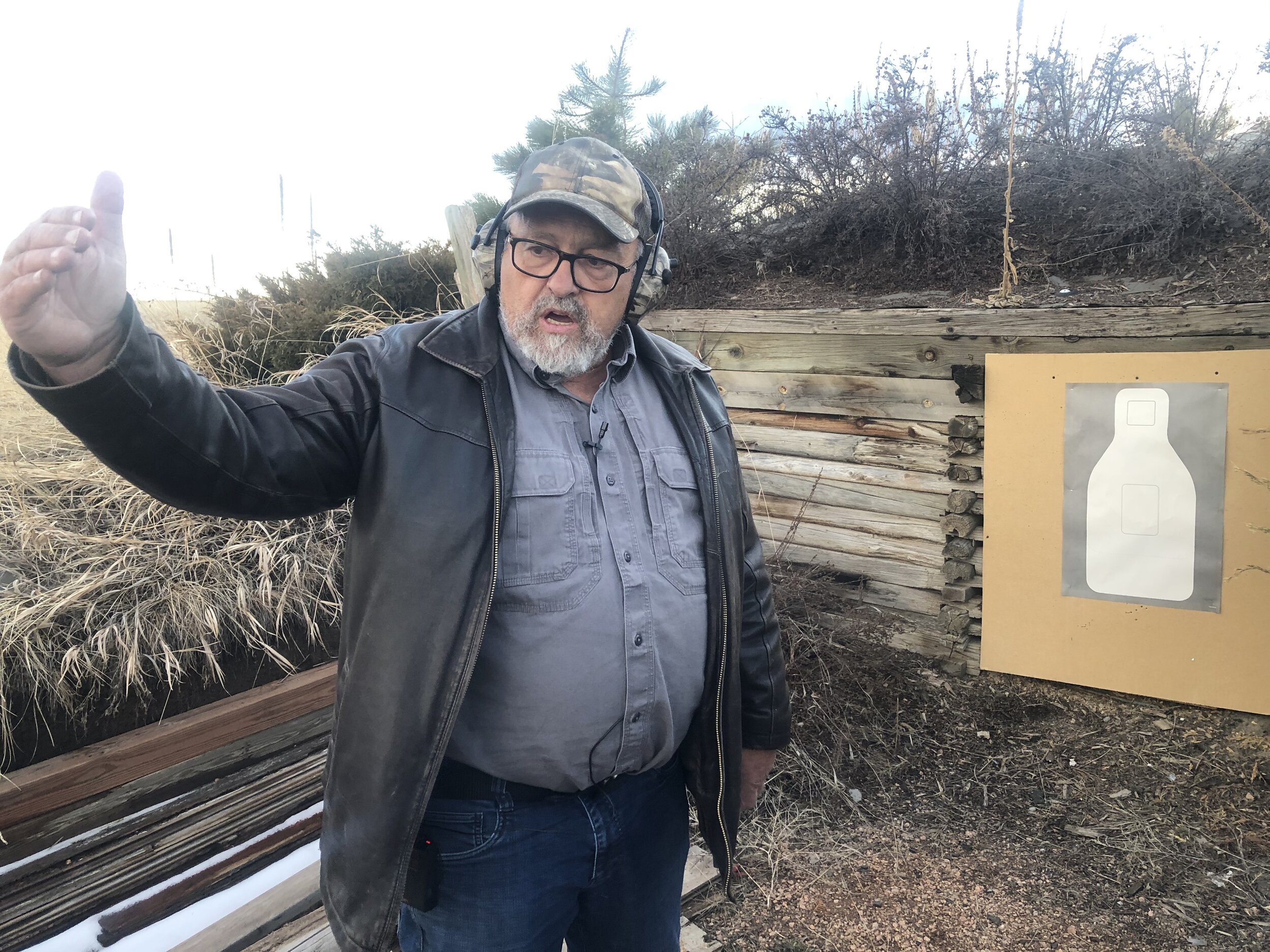
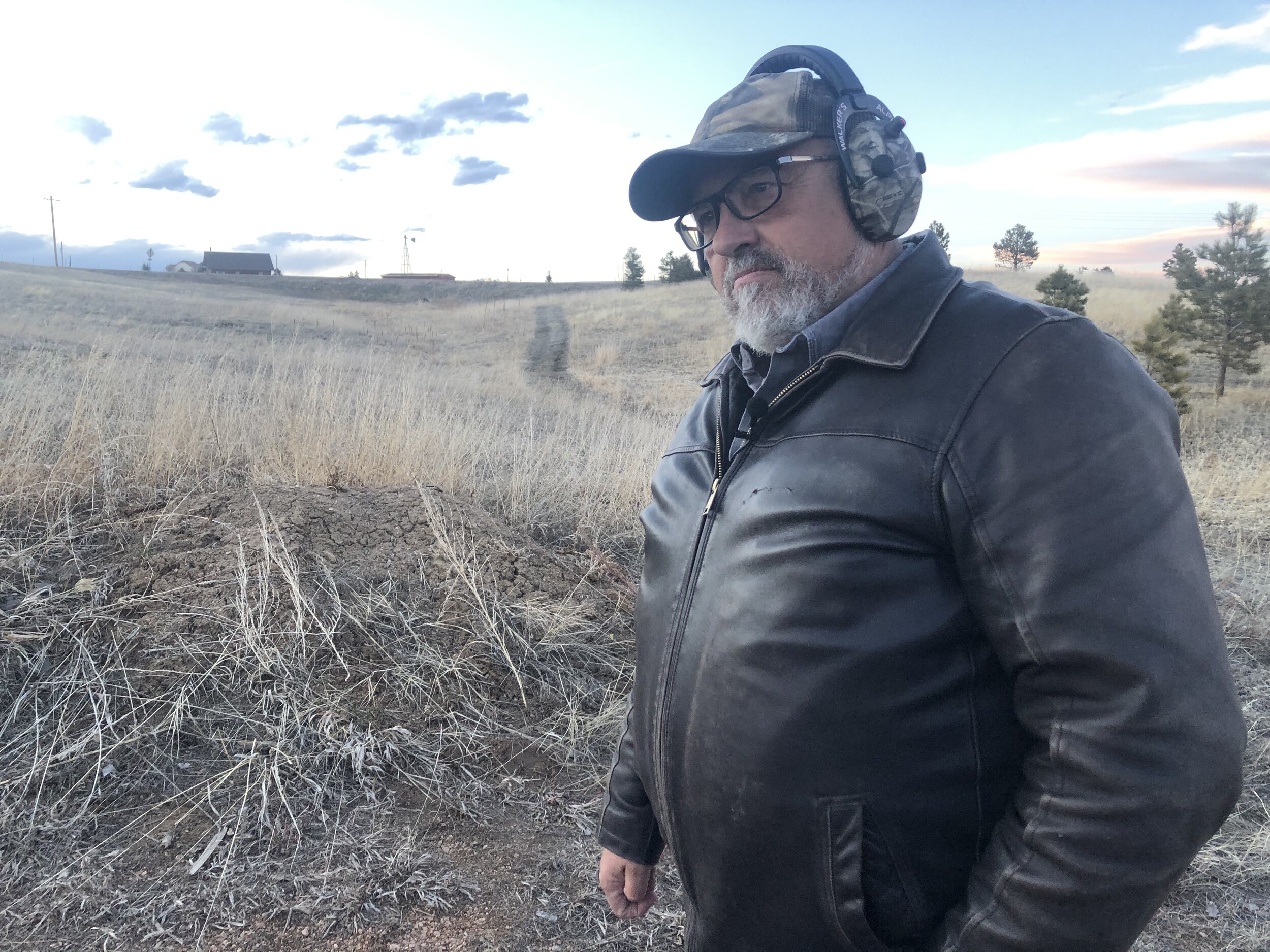
“Clear back to the times of Christ, protection was taken seriously,” Chinn says, warming his hands near a wood-burning stove in his barn after demonstrating proper shooting technique at his private, outdoor gun range. “David was the model of the warrior, the warrior king. He was a special ops king.”
Chinn also points to circuit-riding preachers in the old American West who carried a Bible in hand and a pistol in their pocket. “Protection was a way of life in those days.”
Chinn says we may be in a new era of security and protection for houses of worship. But that’s because the United States skipped a century of security and became complacent. “About 1900, we got this westernized, pacified thing that said the police will protect us. We started shirking our responsibility as citizens.”
In 2012, Chinn wrote “Evil Invades Sanctuary,” a manual on the need for church security. He started speaking in churches nationwide and is often on the road for weeks at a time. In 2016, he started the FBSN, which now includes 43 states and Washington, D.C. He started studying deadly force incidents at places of worship and maintaining a database of them when he couldn’t find other existing databases. He created new kinds of statistics to track violence at places of worship and has catalogued 1,700 such incidents — including 479 murder events of 618 victims — between 1999 to 2017. He found that 2017 was the deadliest year for U.S. religious institutions, with 114 deaths recorded out of 233 total incidences. He does not yet have full figures for 2018 or 2019.
One element of serious Christianity, as in Judaism and Islam, is hermeneutics, the branch of knowledge that deals with textual interpretation. Evangelicals believe that each person can and should study the Bible and consider its meaning for oneself (in addition to learning from a minister).
This methodology extends itself to church security. Discussions and debates are celebrated and encouraged, but feuds sometimes emerge between rival training organizations or methodologies. Chinn notes that his training organization, FBSN, and its larger and older rival, NOCSSM, don’t exactly get along or recommend each other.
A Political Ground Game
Chinn’s group and others are involved in legislation. While churches are embracing the idea of volunteer armed security teams, churches and nonprofits are also lobbying for favorable legislation in several states.
“Our state is adjusting legislation to meet the varying needs of congregations,” said Dr. Will Hall, director of the Office of Public Policy for the Louisiana Baptist Convention. He said Louisiana previously mandated that church security volunteers take an eight-hour tactical training class to conceal carry on a church campus. Now, the law allows churches to determine for themselves what requirements such armed security team volunteers must meet. Hall’s office is working to keep churches free to make their own decisions about security teams possessing weapons as a tactical defense strategy.
This freedom was granted by Louisiana lawmakers largely because no universal standards exist for tactical training nor in the qualifications for instructors, Hall said. He said the insurance industry is researching the matter and likely will weigh in on what churches must do to qualify for protection policies in the future.
Christy Gooding of Des Moines’ Guide One, an insurance agency for churches, schools and businesses, said her organization initiated security training for churches Aug. 19, 2019, and works with Strategos International to provide intruder response training in classes and through the web.
Jeff Renbarger of Fort Wayne, Indiana-based Brotherhood Mutual Insurance agrees that training is key. “We are a major proponent of organized and trained security teams and security plans,” Renbarger said, adding that security plans can be tailored to the church as one size doesn't fit all. Brotherhood Mutual created church security and safety training resources a decade ago, with the idea that they could be part of the ministry, and created a publication on safety and security. The training of a defense team doesn’t impact the underwriting pricing, but it can help reduce dangers, Renbarger said.
“An active shooter situation is a small percentage of overall church occurrences,” he said, adding that churches should be ready for medical emergencies and a variety of other unforeseen events that could happen during a service. “A well-trained security team can be another way to have an additional welcoming and hospitable ministry.”
Some church security experts say churches use the term “life safety” teams instead of “security” teams because the former description provides better legal protection.
Data shows that most violent incidents happen in the parking lot. And many violent incidents at churches are connected to domestic disputes that cause one party to bring violence to a church. “We want the broken and hurting to be here,” says Henry, the life safety team leader at Mountain Springs Church in Colorado. “We just don’t want them to hurt anybody else.”
Henry asks all team members to attend two quarterly training programs per year. They also have up to seven gun range trainings per year at gun ranges on the property of church members. He uses FBI and National Rifle Association training materials and tests with his team.
“It raises the question: Why would we lower our standards to FBI standards?” one team member joked.
Henry said life safety team members and church members should not only think about guns as primary weapons to stop attackers, but also improved weapons: a hot coffee pot, for example, is a great weapon. “Dump coffee on someone!”
The Clint Eastwood Option
In the 1985 film “Pale Rider,” Clint Eastwood plays a mysterious preacher who arrives in a small mining town when a woman prays and quotes Psalm 23 as she seeks protection from thugs bent on rape and assault of townspeople. Eastwood’s character, “the preacher,” beats the villains in the movie with the hickory handle of an ax, his fists and guns. “Well, the Lord certainly does work in mysterious ways,” he says after trouncing one of the bad guys.
The film’s title is taken from the book of Revelation, chapter 6, verse 8, which reads, “And I looked, and behold a pale horse: and his name that sat on him was Death, and Hell followed with him.” The film teases the tension between earthly retribution and divine retribution.
While blogger and author Rod Dreher wrote a recent book titled “The Benedict Option” extolling the virtues of close Christian community in a secular age, many Christians are now extolling the Clint Eastwood virtue of gun-slinging to combat the assault on religious people and religious values, whether it comes from secularists, terrorists from radical religious organizations or mentally ill attackers.
And kibitz as they may, the recent shootout in Texas showcased and validated the ballsy, gun-toting, sharp-shooting, Bible-quoting men (and a few women) they aspire to be. West Freeway was not an aberration or outlier. It was exactly what they envision and what they prepare for day in, on the Sabbath, and day out, during the week.
“Nothing I say diminishes the remarkable actions of the West Freeway Church of Christ security team,” Chinn said. “Richard White died not only that others may live, but that others may learn.”
At Mountain Springs Church, the Saturday training lasts seven hours. After the morning simulations, a youth pastor named Evan Stone stops by to give a message about how to exercise defense against attacks but also to create a safe and welcoming space for young people, including angsty junior high and high school students, who attend the church. He challenged the group to help the students feel “you belong here.”
“How do you teach kids to give a damn about authority?” asks one life safety team member.
“Make sure they know you care,” Stone says. “The more we do, the more we soften the walls around their hearts.”
After a pizza lunch, a group drives 15 miles to the private, outdoor gun-range in a manure-dotted grazing pasture of a fellow church member. They park their (mostly domestic-made) pickup trucks and sport utility vehicles, load their target ammunition, holster their guns, plug in their earplugs and navigate a series of shooting drills in the cold, biting March air.
“This is not shooting practice. We all know how to shoot. That’s pretty simple,” Henry says. “This is practicing to fight with a handgun. That’s a different mentality… That’s a different animal.” He says they are training not just to win, but to prevail. “We want absolute domination over that evil that is attacking and trying to destroy God’s gift of life. It has to happen fast and accurately.”
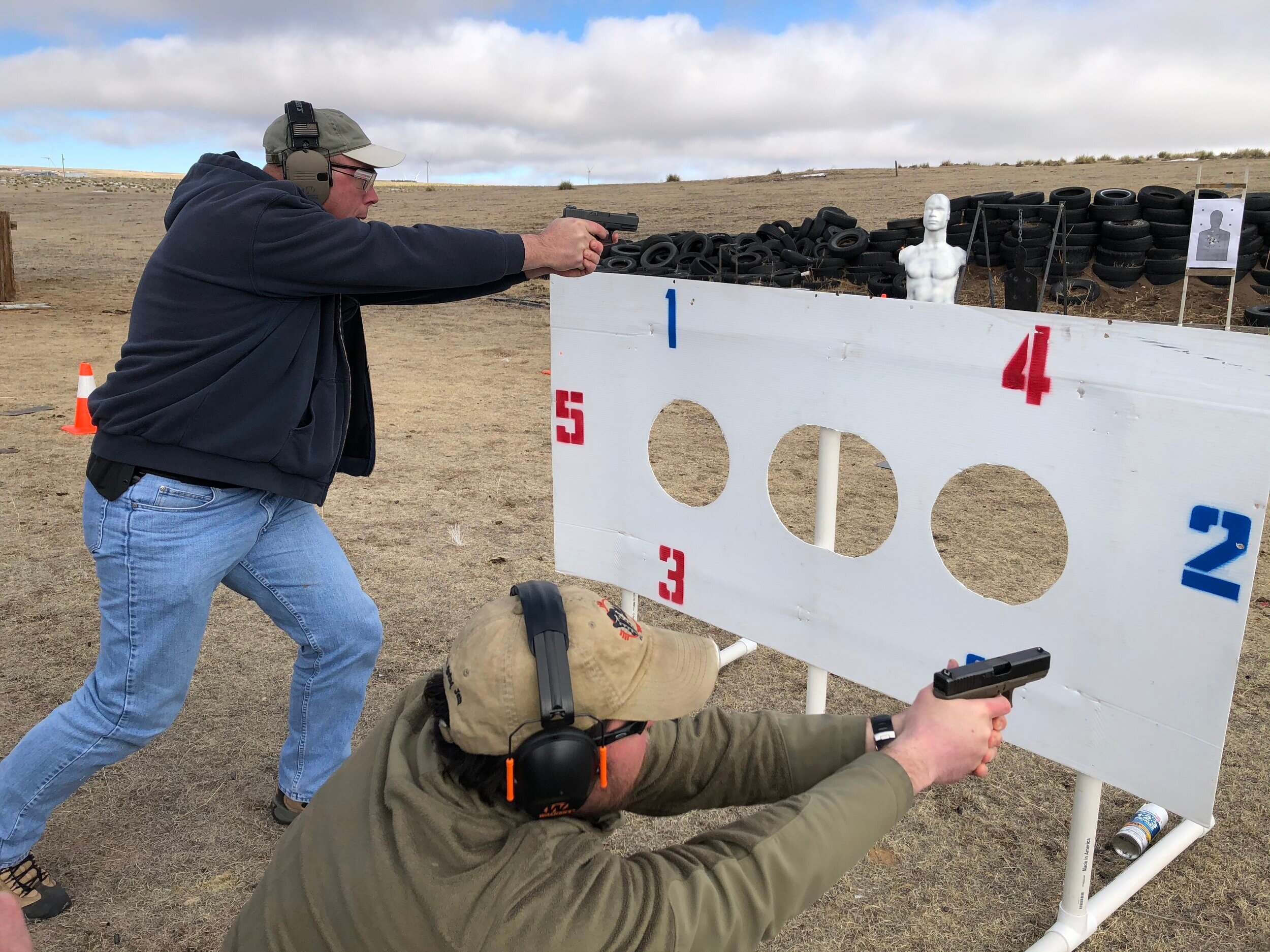
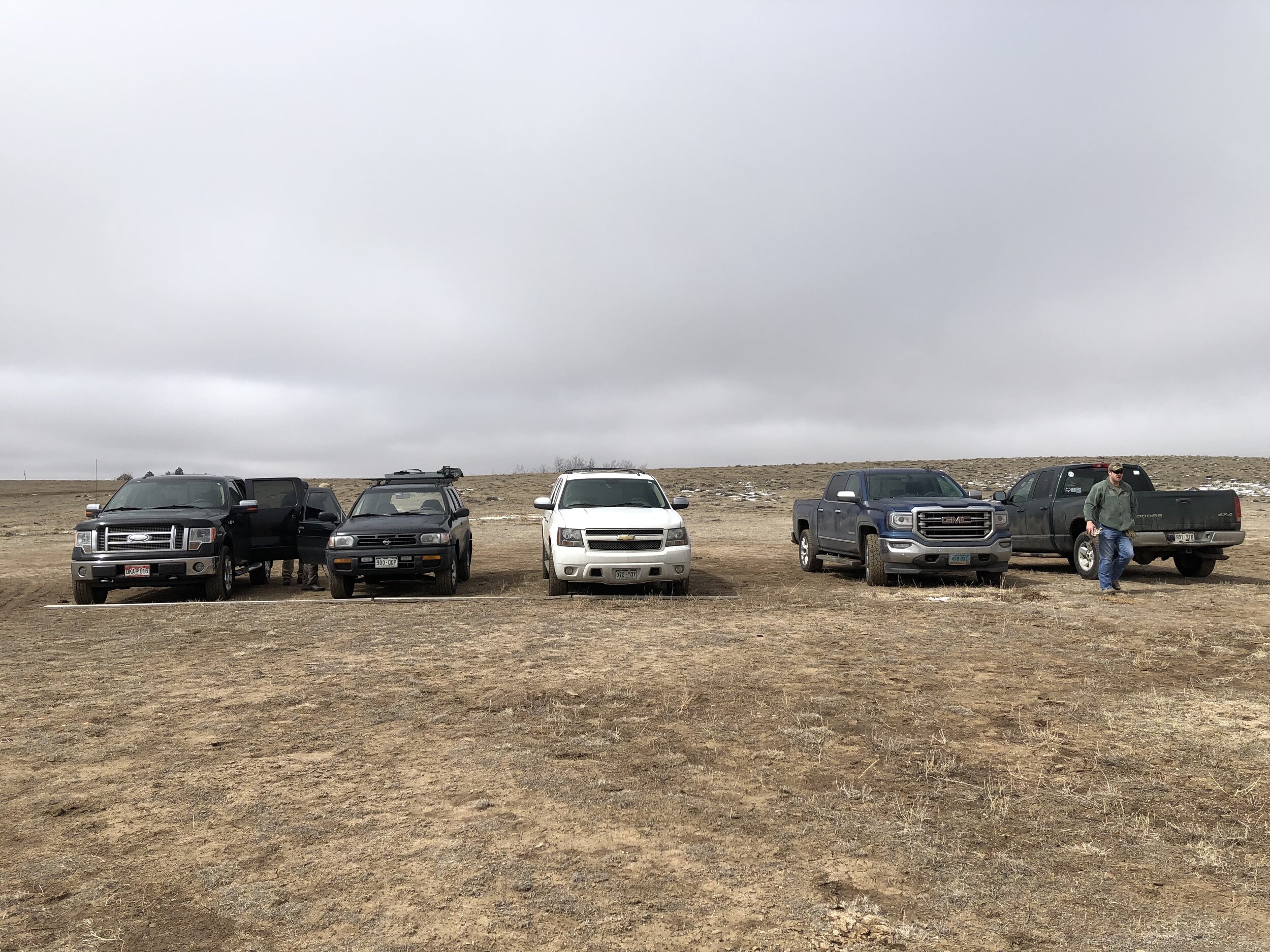
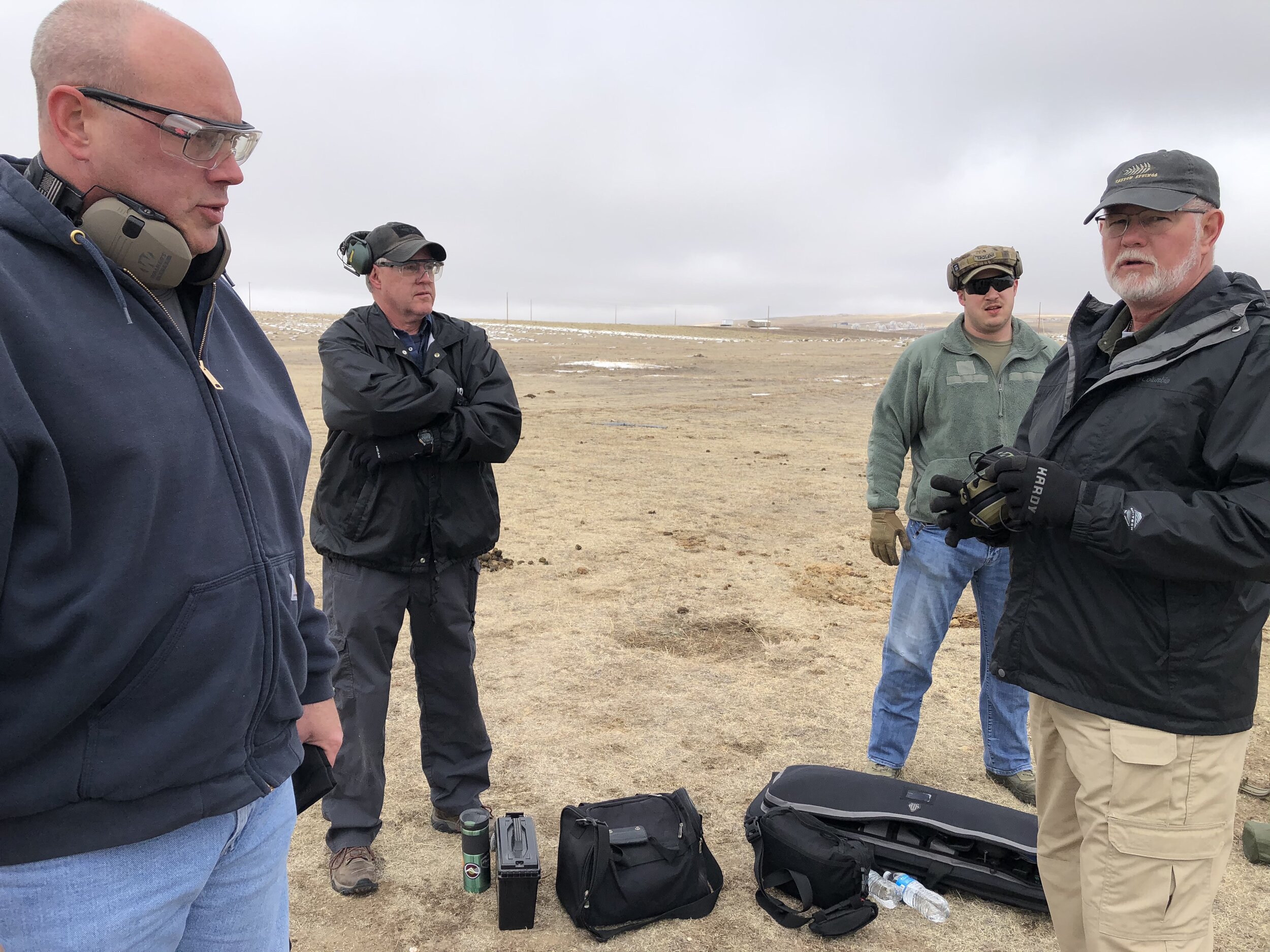
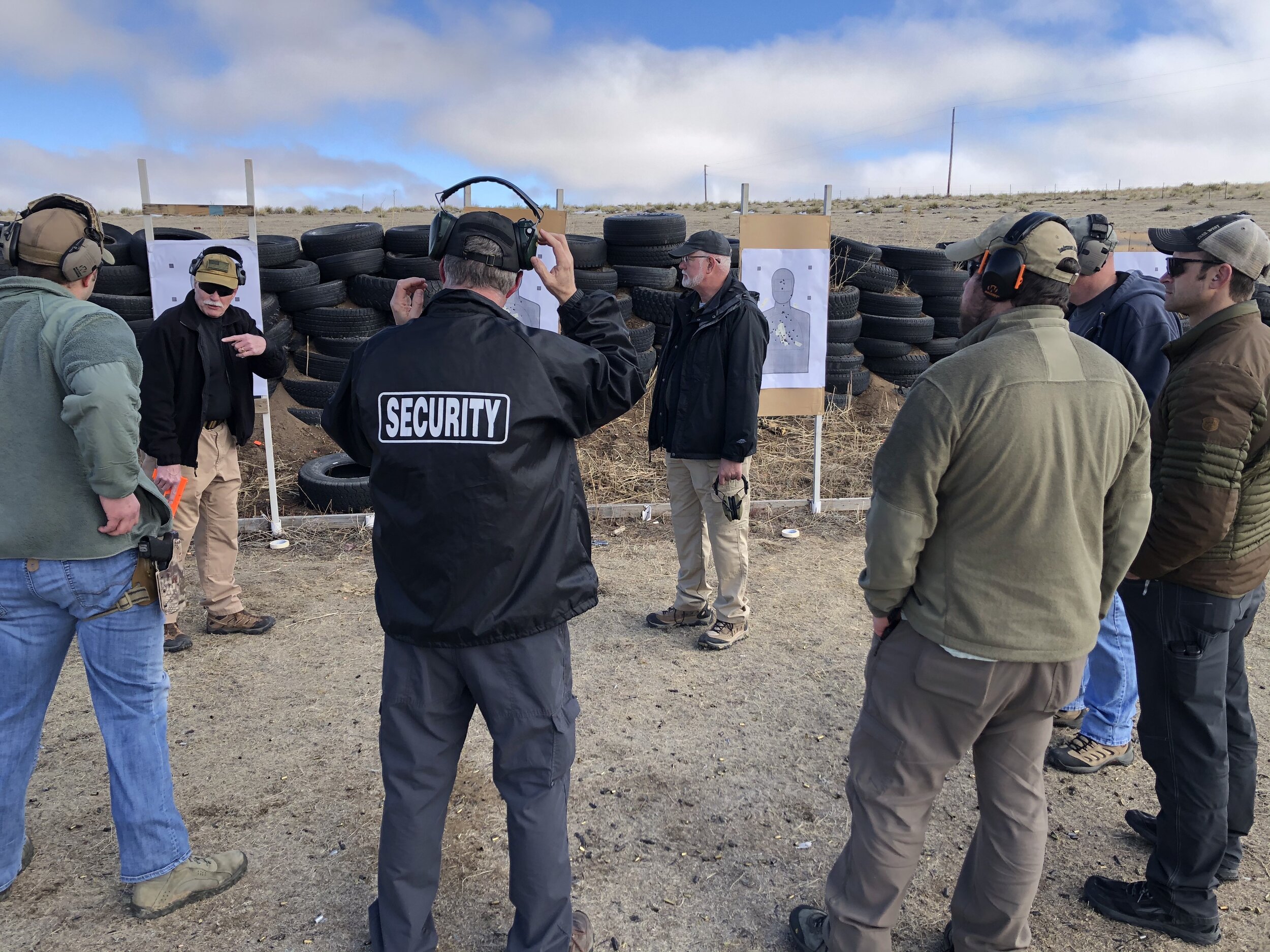
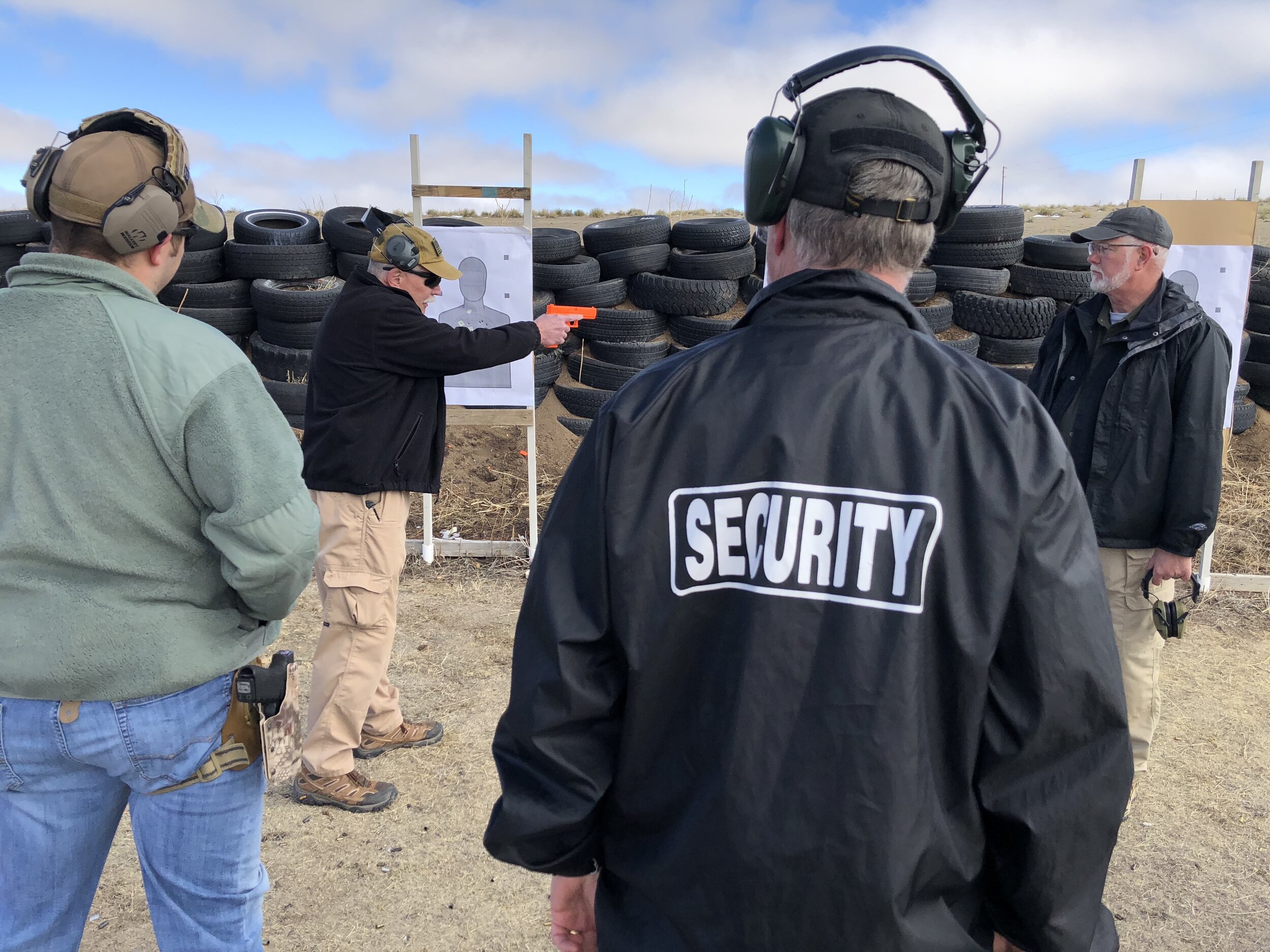


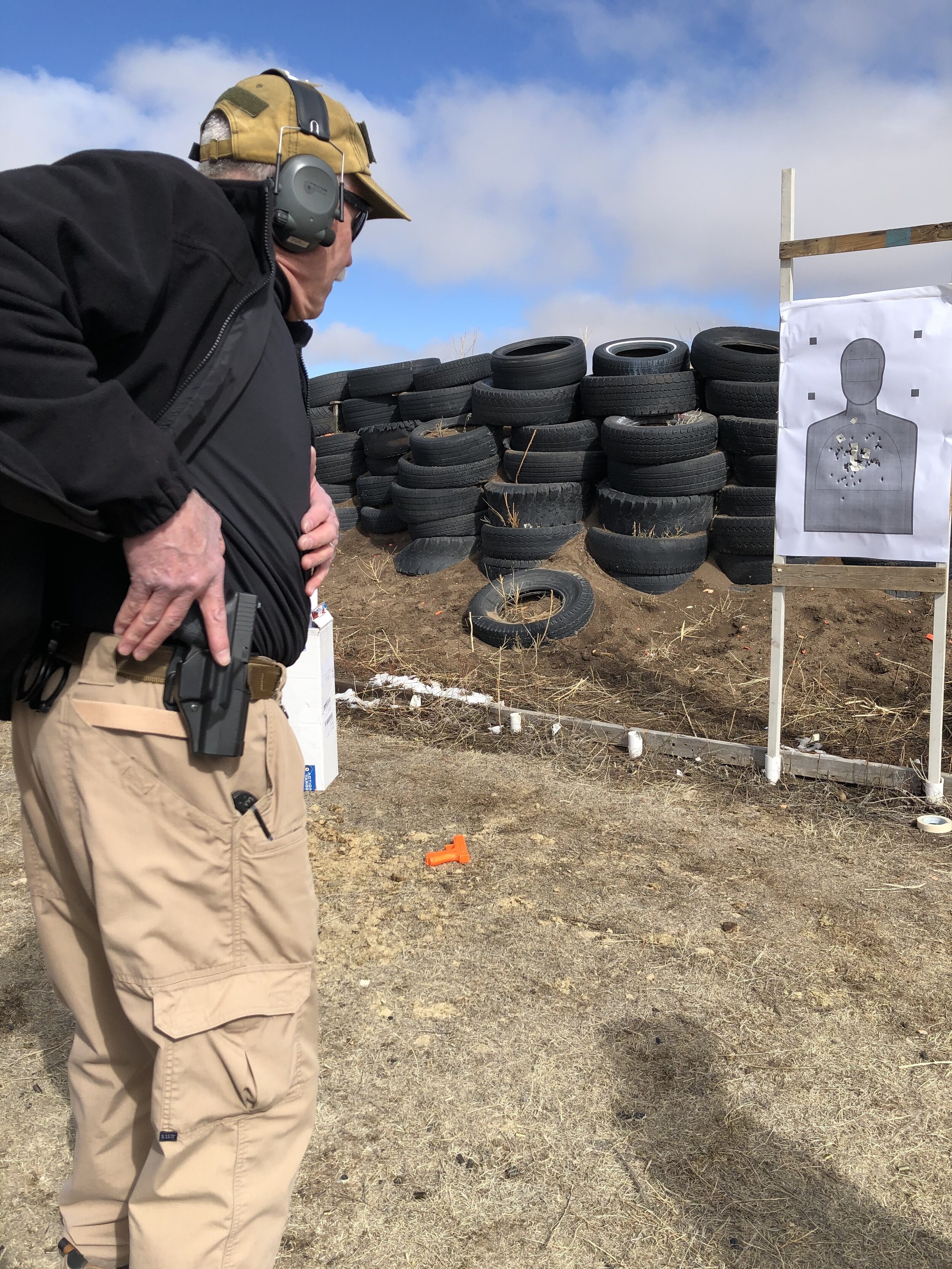
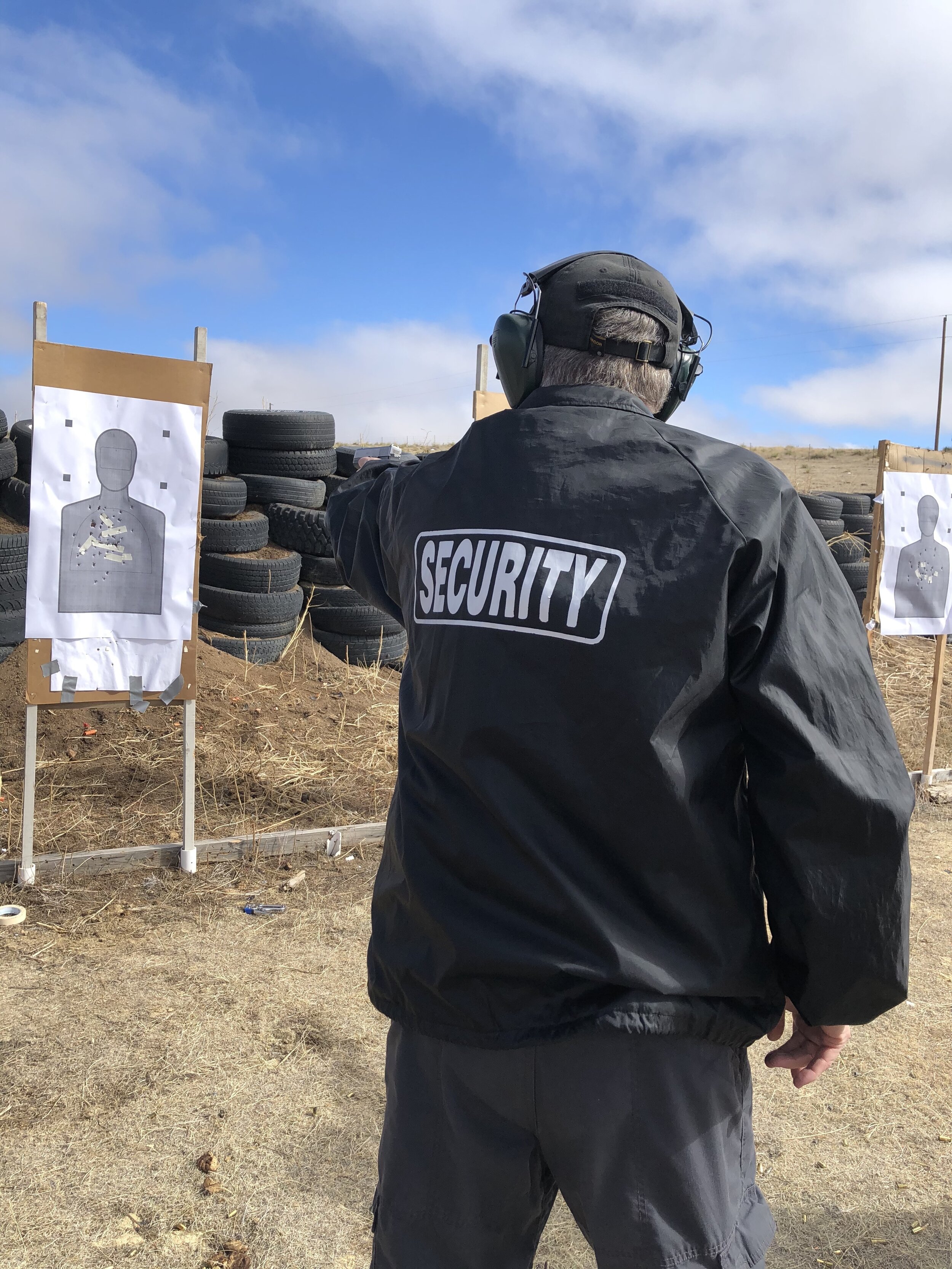
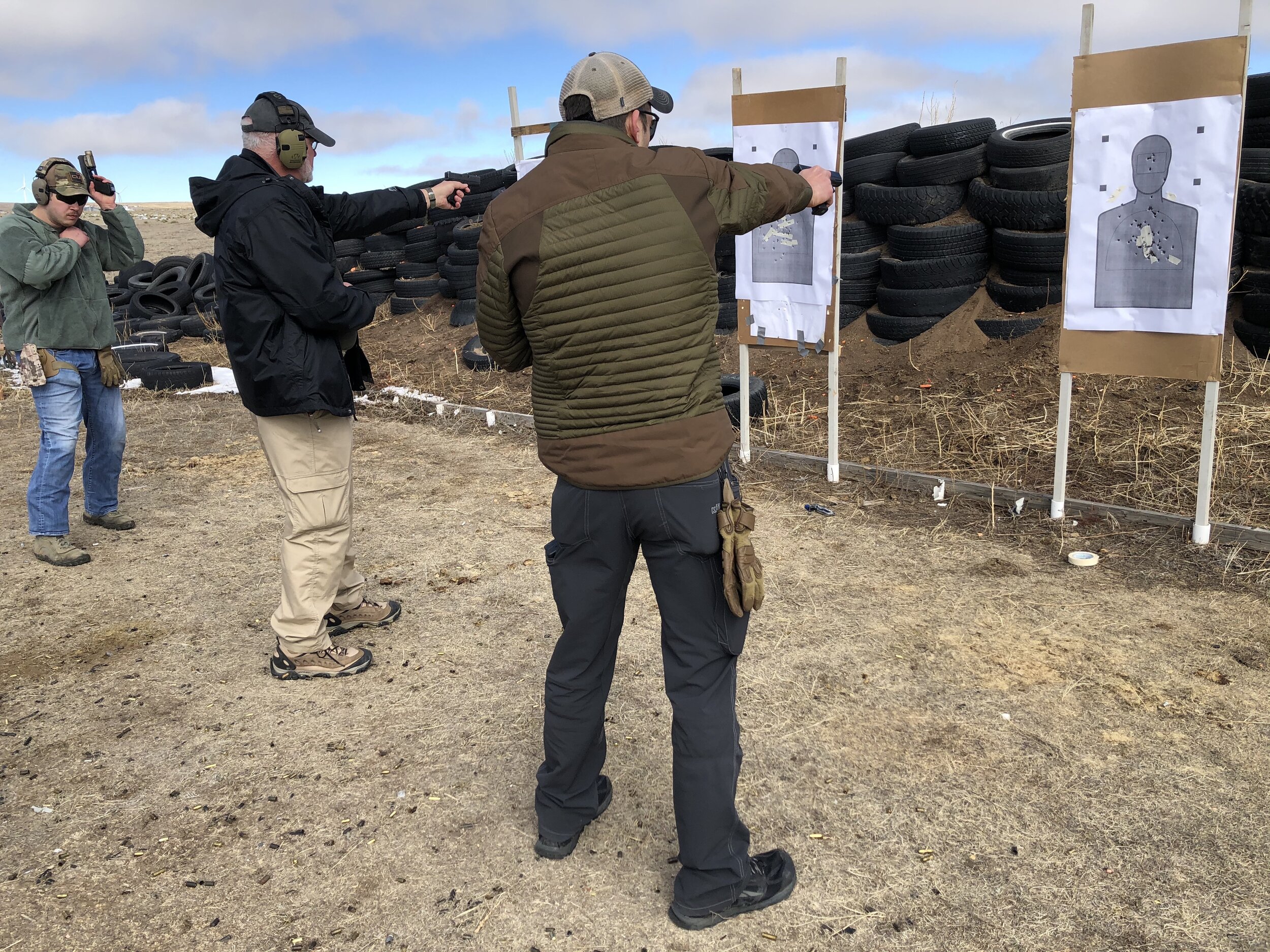
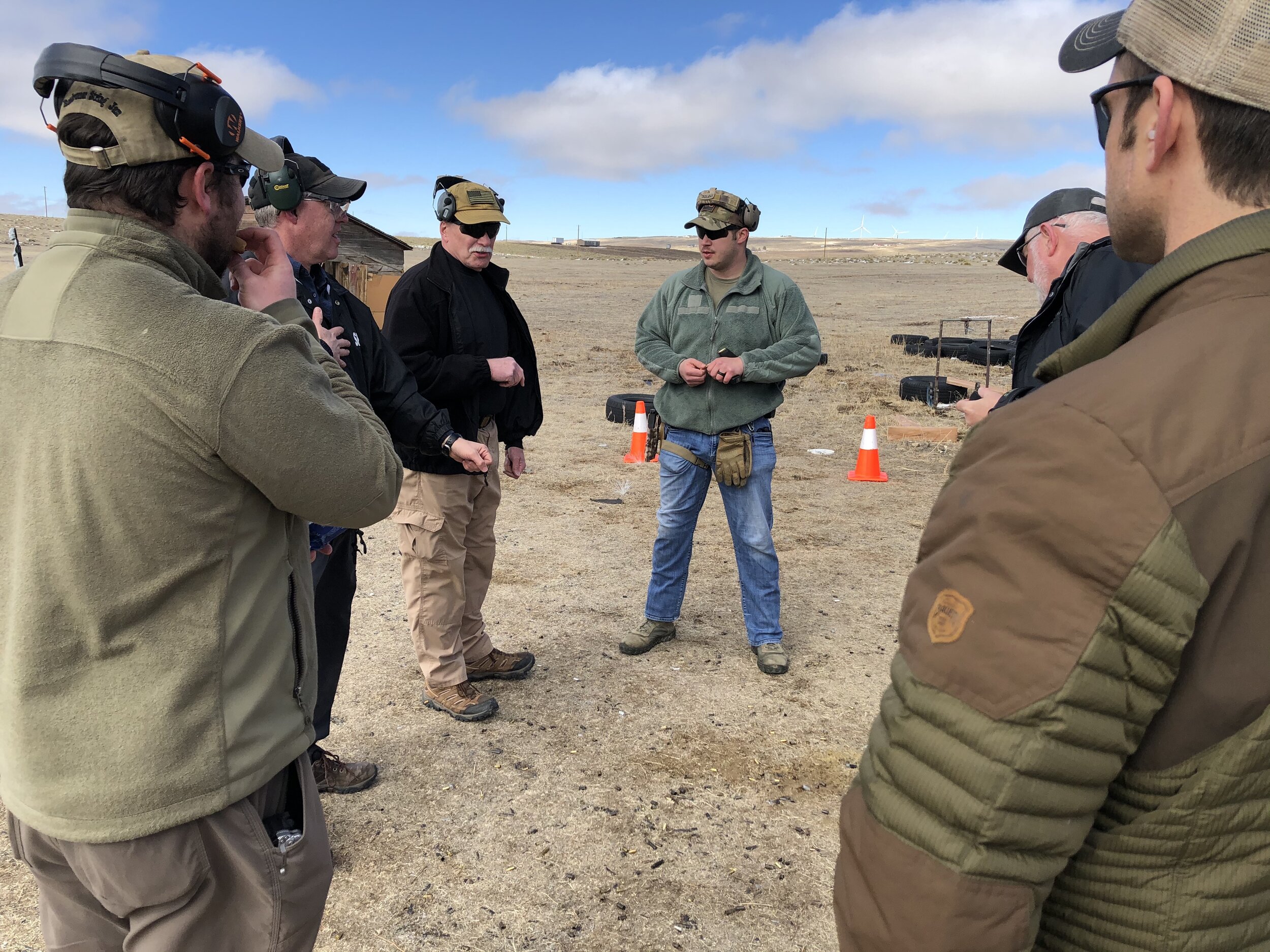
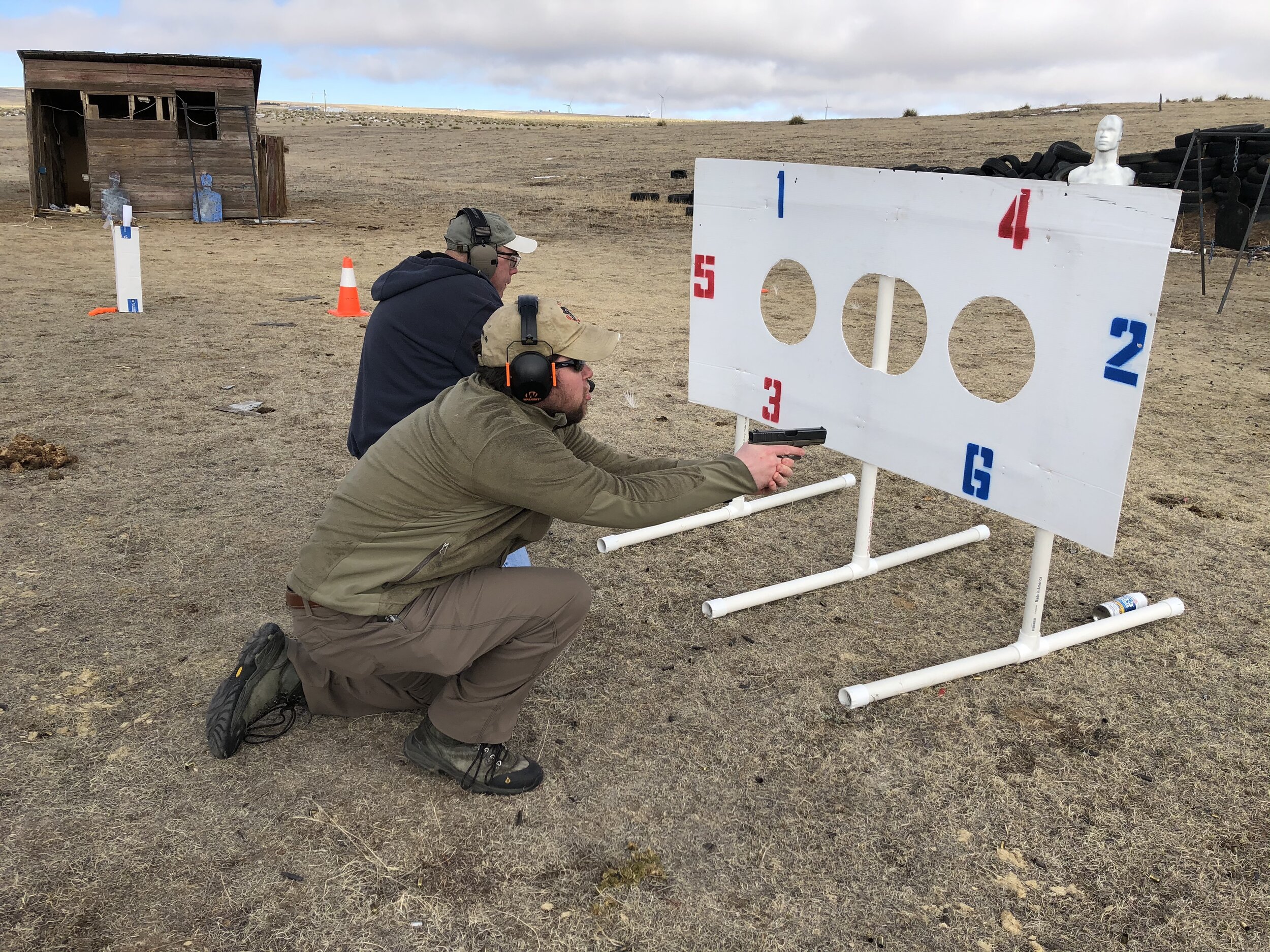
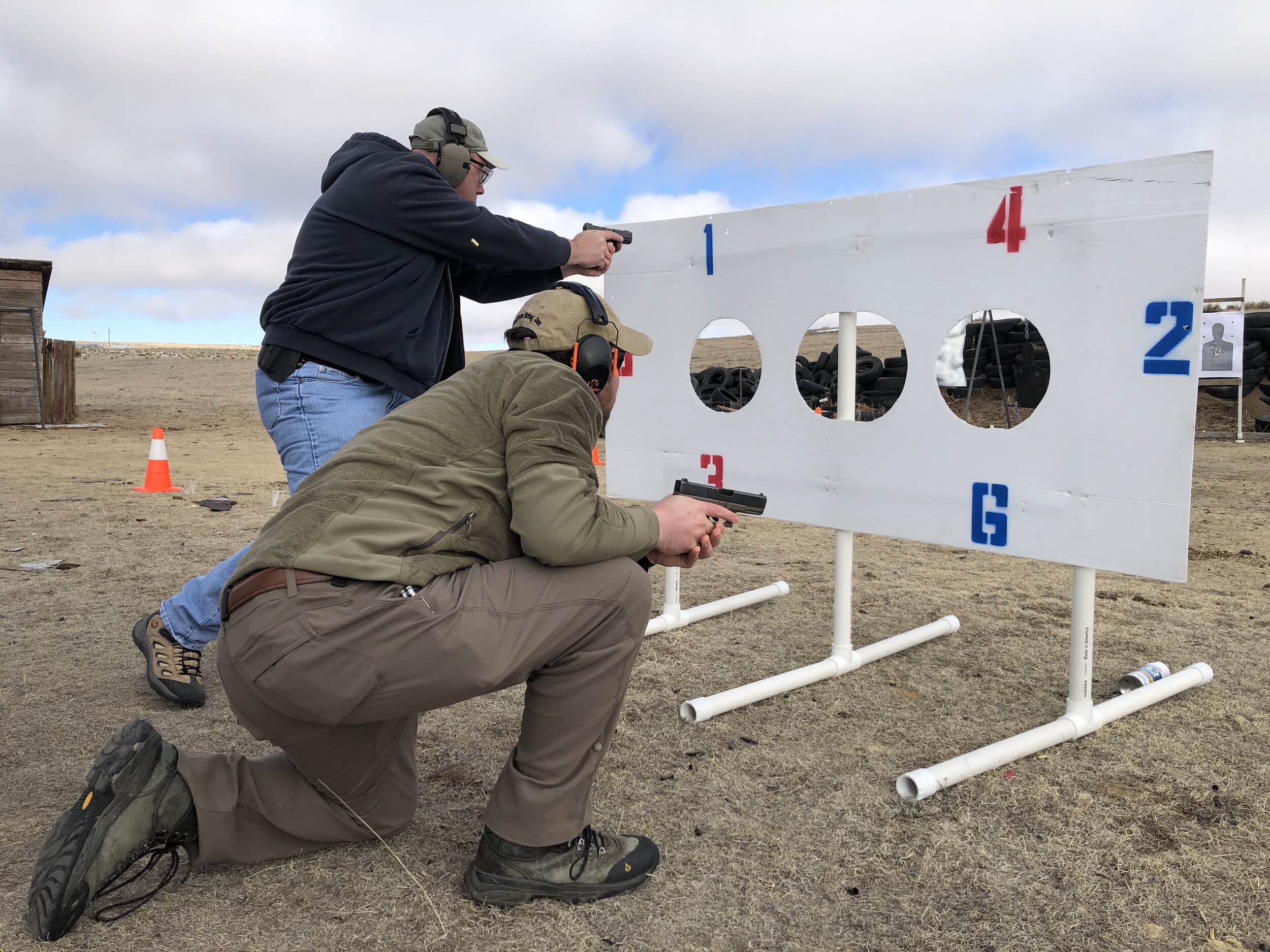
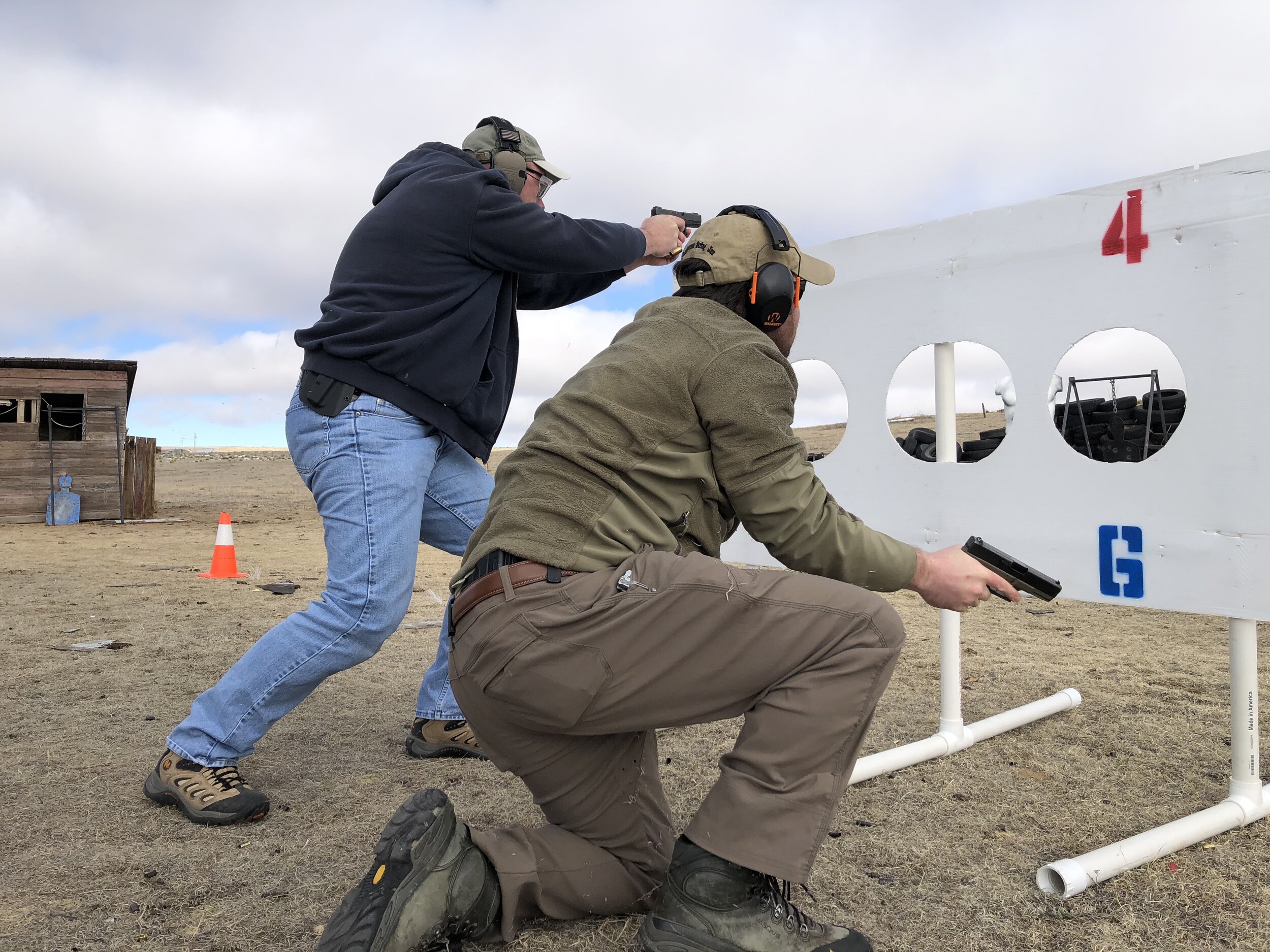
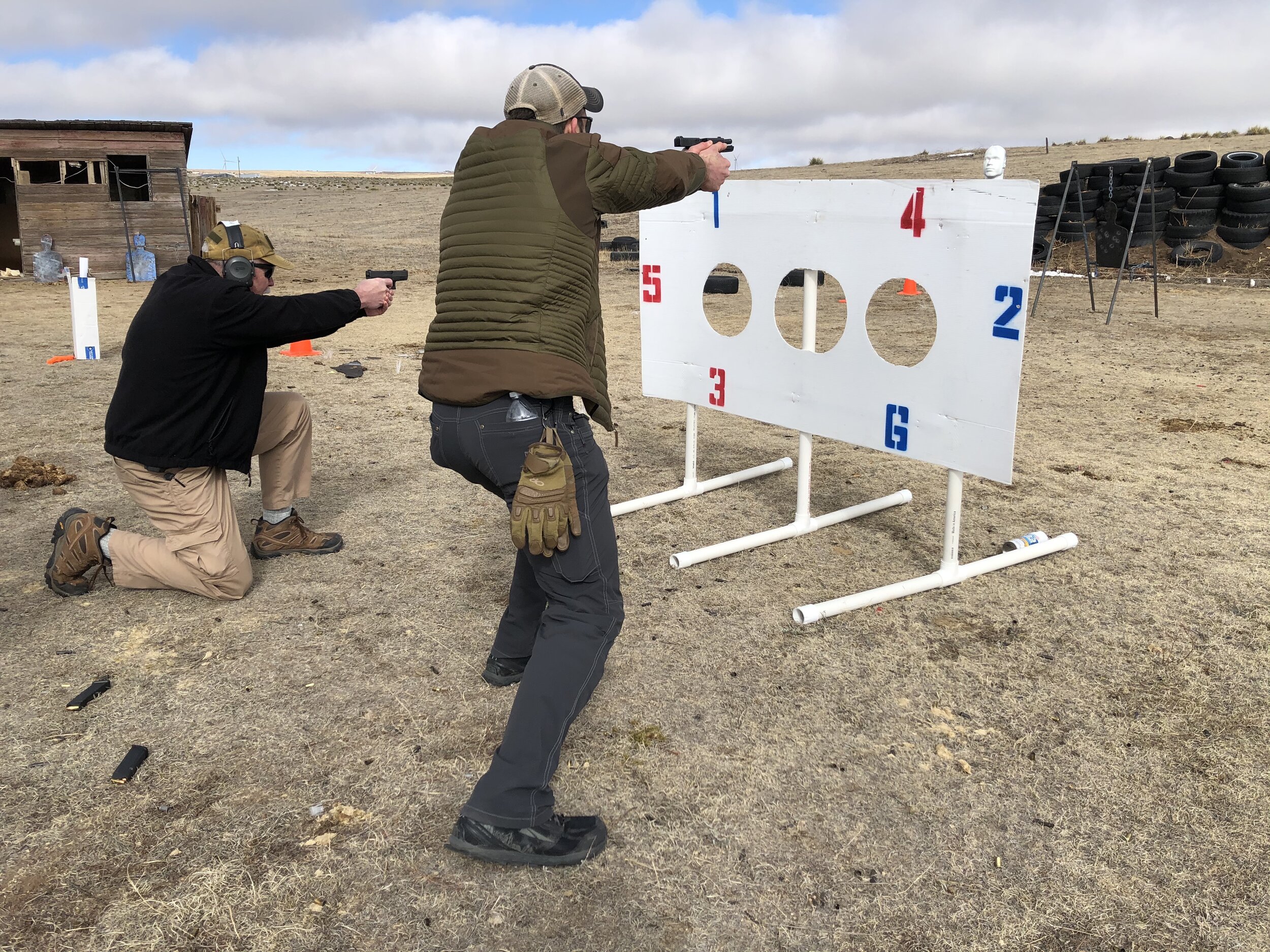
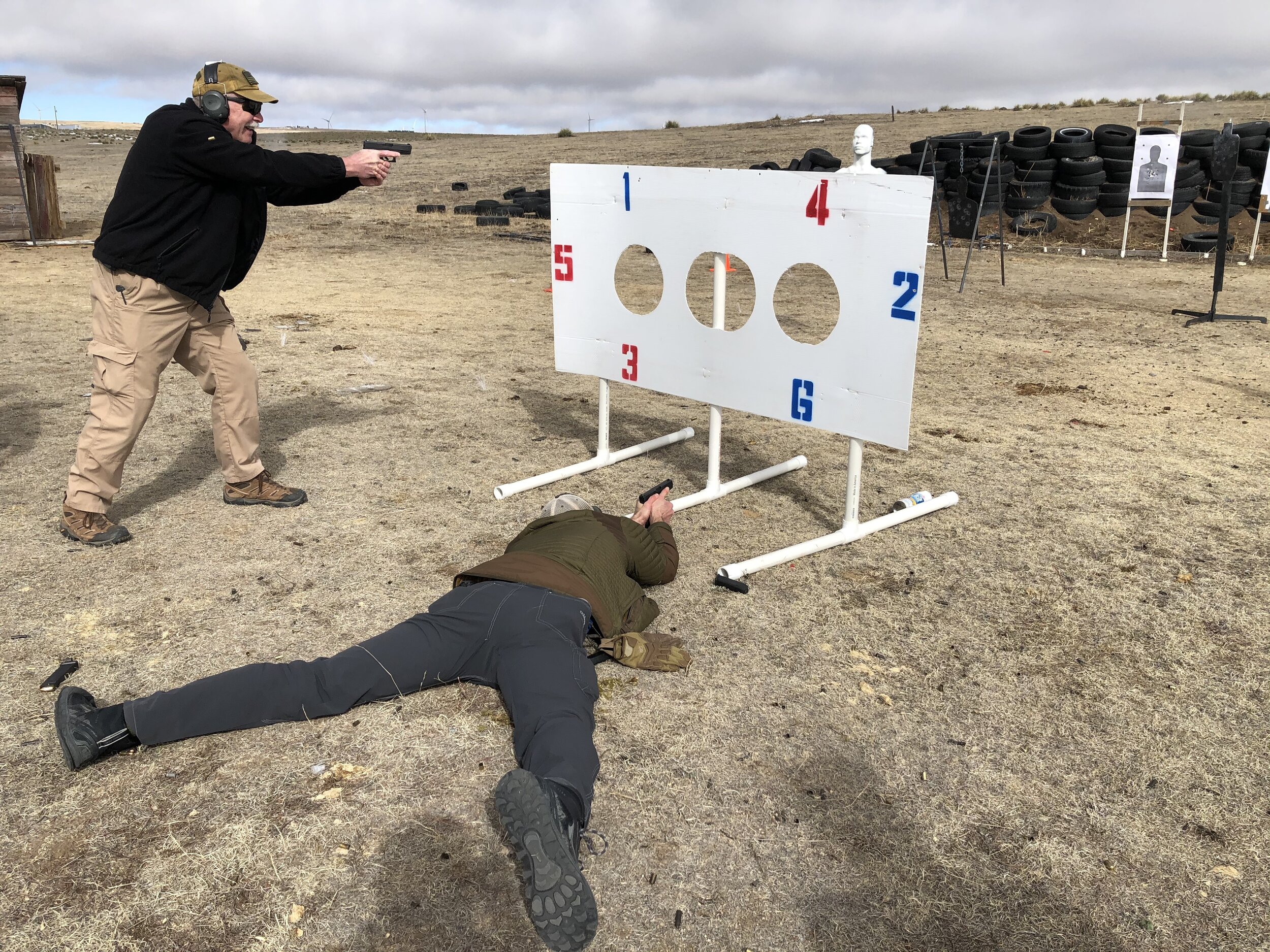


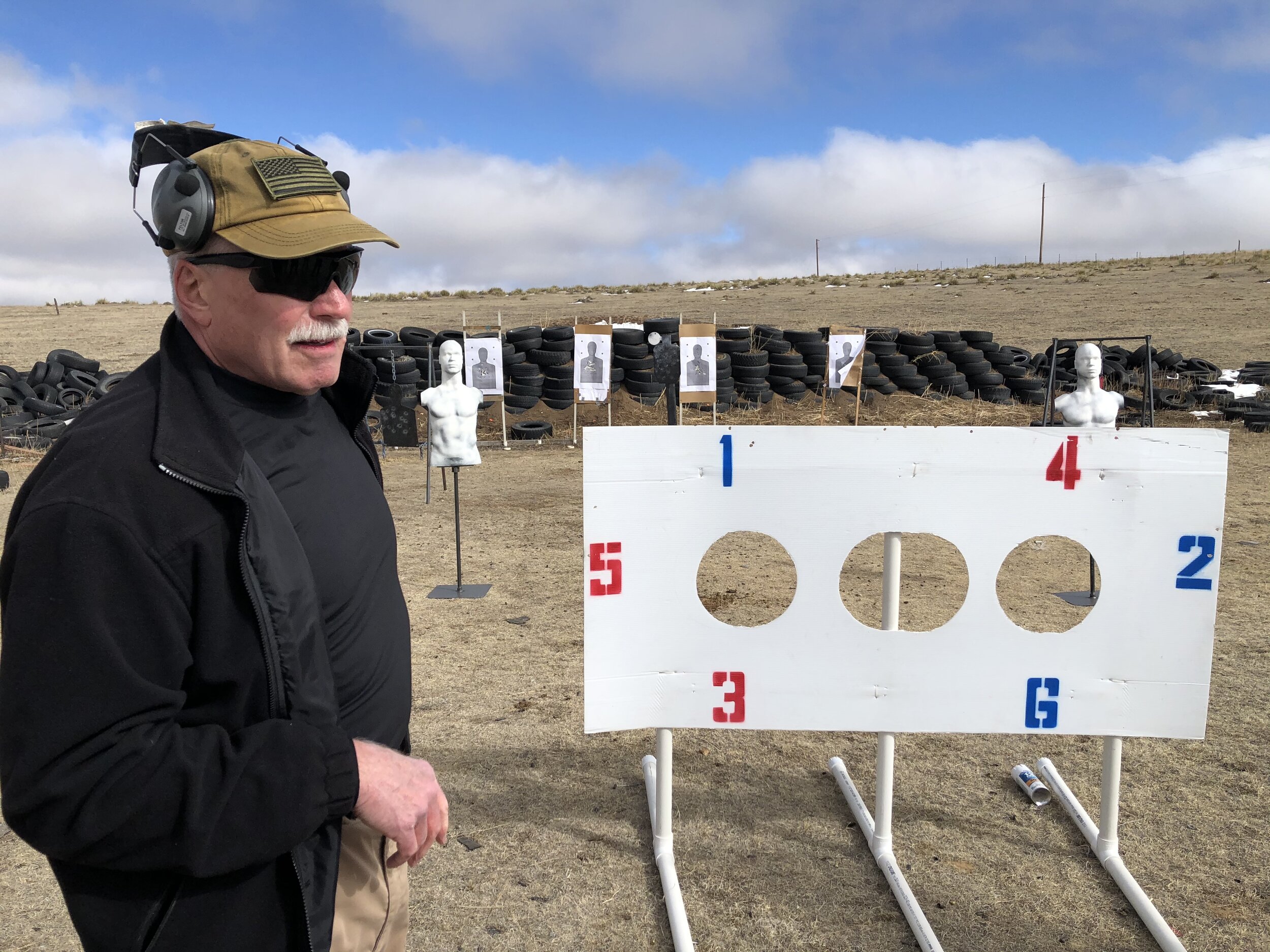
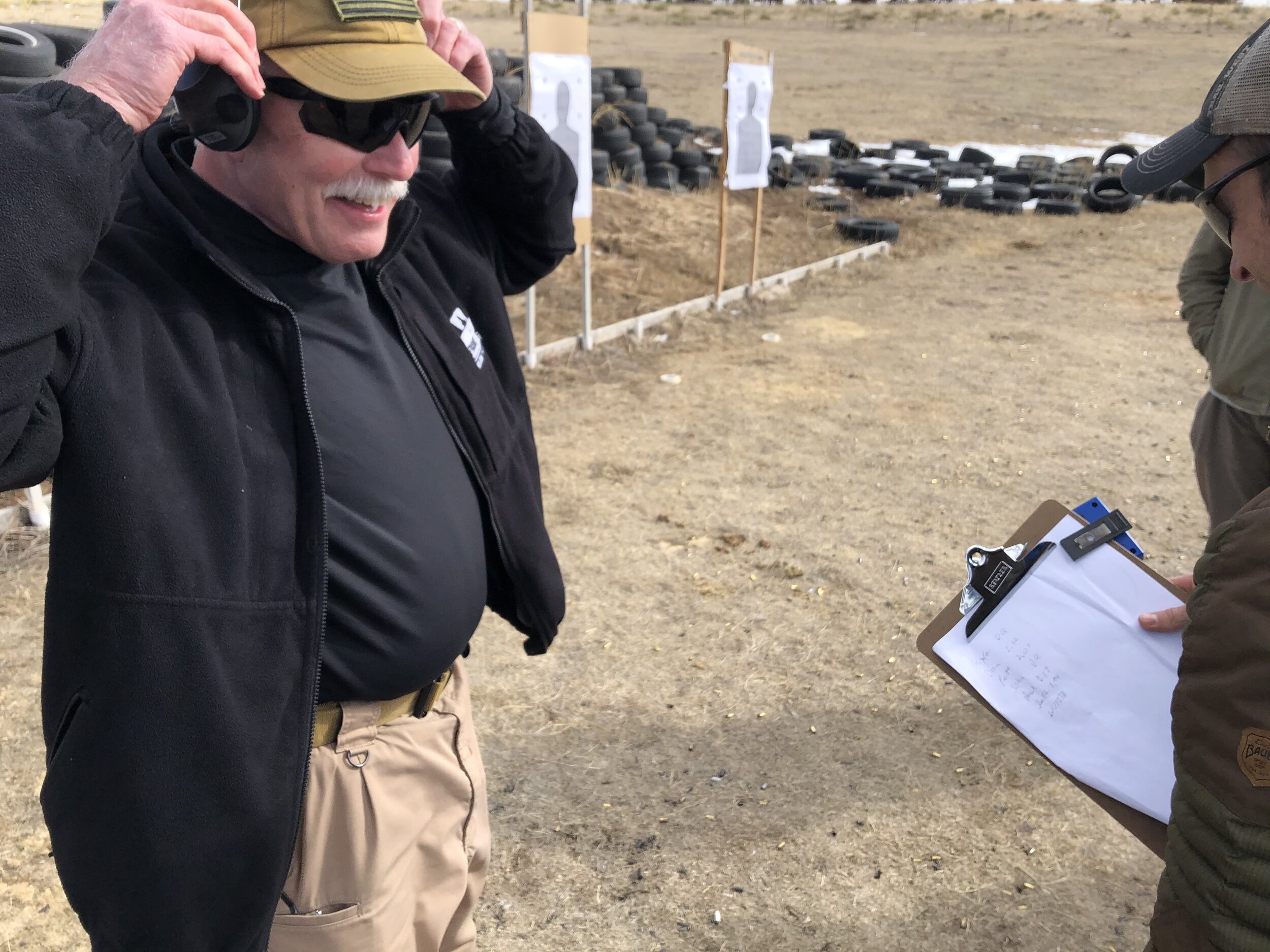
First, Henry guides them to draw their weapons and hit a target — an outline of a human form with the thoracic cavity and head marked as target zones — from a few yards away. Then, he walks them through a series of more complicated shooting drills leading up to an obstacle course where two gunmen run toward a “Wilson Wall,” which they crouch behind while shooting past foam dummies and trying to hit two hanging steel targets. Bullets zip, bite and smack into the steel plates with sounds like “PING! TING! POP!”
As they run through the training, the men call out phrases like, “Dave, are you good? Call 911!”
Other men distract the shooters by swatting at their backs, yelling things like, “We’re all gonna DIE! Look OUT! They’re gonna GET ME!”
As a final training drill, he asks each man to draw a handgun and fire two rapid shots as accurately as possible. Henry records the shots with an audio box that measure response time. He says this drill simulates the West Texas shooting from December and dares the men to draw faster than the gunman did.
One by one, the men attempt the quick draw challenge. Two are disqualified for missing the small bullseye. A few others log scores between a two-second and three-second response.
“Not too shabby,” Henry says.
When his turn comes, Henry whips out his gun and buries two shots in the bullseye zones — shots to the thoracic and head area of the target — in 1.94 seconds. He looks over the results and shows the men the door prize that he, alas, must keep: a maroon coffee mug that says, “Good Morning. This is God. I’ll be handling your problems today.”
“I was a bit disappointed with my time. I bobbled my weapon presentation a little. I usually do about 1.26 – 1.35-ish on that drill,” he said a week later in a text message. “I was really happy with everyone’s times overall. Everyone (and even the DQ’s) had shots that would have likely saved the day at the WFCC attack in TX.”
Paul Glader is executive editor of ReligionUnplugged and a professor at The King’s College in New York City, where he directs the McCandlish Phillips Journalism Institute. He spent 10 years as a staff writer at The Wall Street Journal. Michael Ray Smith is a journalism professor and journalist now based in Pennsylvania. He taught journalism at Lee University in Tennessee, Palm Beach Atlantic University in Florida, Campbell University in North Carolina and, most recently, LCC International University in Lithuania.
Earlier in this Collection
-
A gunman opened fire during the Lord’s Supper at a Church of Christ in Texas Dec. 29, killing two worshipers. Armed members immediately returned fire and killed the shooter at the West Freeway Church of Christ in the Fort Worth suburb of White Settlement.
-
The congregation of West Freeway Church of Christ, about 280 people, came together a day after a gunman killed two of their flock and an armed member fatally shot him.
-
Preacher Britt Farmer lost his best friend in the Sunday shooting at a Church of Christ near Fort Worth. At the same time, the close-knit congregation 10 miles west of Fort Worth had beefed up its security team and trained members for a real-life nightmare such as this.
-
Hundreds of mourners, including Texas Gov. Greg Abbott, paid tribute to volunteer security team member Richard White, who died Sunday in a shooting at West Freeway Church of Christ near Fort Worth, Texas.
Up Next in this Collection
-
Locked and loaded parishioners acting like John Wayne of the church pews may be a new chapter in church history. Historically, Christians were hesitant to deploy violence for self-protection. While the Bible and church history illustrate tension around violence, armed resistance isn’t completely foreign to Christendom.
-
A growing Christian security movement focuses on training churches and ministries how to protect their congregations in case of gun violence.
-
JB isn’t alone. Americans from the ideological left, right and middle – and every stop in between – are increasingly trying and buying guns. Their fear is multi-fold: a Coronavirus pandemic, an uptick in unemployment and violent crimes in major cities, public unrest related to racial injustice, ideology-driven street battles between ideological foes and a presidential election that already has tones of conspiracy theories, recounts and allegations of fraud. What’s the evidence that this trend is true, beyond JB’s interest?
-
After a shooting in 2019 that claimed the lives of two congregants, the West Freeway Church of Christ in Texas rebuilt their worship center. They have now returned to worship after the COVID-19 lockdown and completion of construction.



